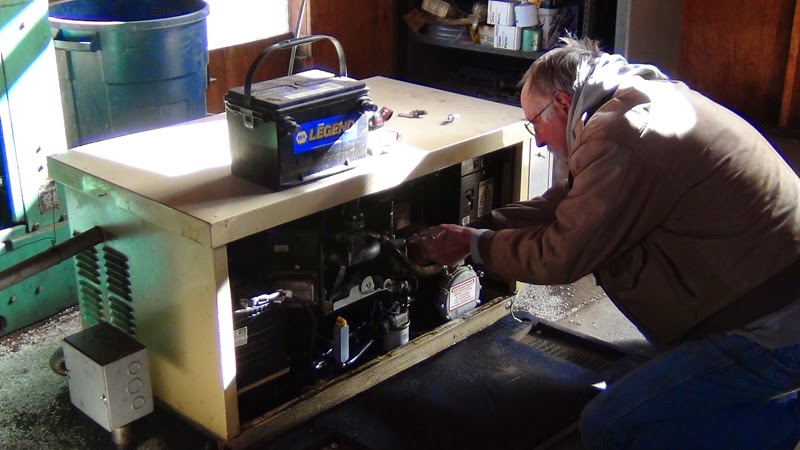In my last post I announced that I fixed the back-up generator better than it was when we moved in here. Well, it lasted one more evening and then it died again. The fault indicator light showed that it was running faster than it was supposed to. These generators are designed to run at a fixed speed. This one was supposed to be running at 3600 rpm which translates to 60 cycles per second on the dynamo part (the part that produced the electricity). It was running too fast and producing AC power at over 70 cycles per second. Appliances are not designed to handle this so the generator shut down.
This problem was more than I was prepared to deal with so we called a repair guy. He came out a few days later and adjusted the governor that keeps the speed constant. After fussing with it for about an hour it seemed to be running fine. We were excited to think that we could watch a movie at night.
But, no. It ran for about 15 minutes and shut off. The same problem. Note that we still hadn't gotten our replacement battery for our solar power system and were still sitting beneath one light bulb hooked to a marine battery so we could read at night.
We called the repair guy again and he said that, if it wasn't the governor (a mechanical thing with springs and such), then it must be the circuit board. He checked to see if he could get a replacement and they are no longer available. The generator was too old and parts were not available for it anymore. We need to replace it.
 |
| Our new battery in place. |
Another week went by and we finally got word that our replacement battery had been delivered to Phoenix. From there it was supposed to go to Flagstaff and, from there, to Chino Valley where we could pick it up. Because of the delivery schedules the batter wouldn't make to Chino Valley until a week later. Fortunately, we had the option to drive to Phoenix and pick it up. So that's what I did.
The next day I connected the new battery into the system. However, new batteries don't come with a full charge on them. The one we got was in the same state of discharge as our remaining old batteries. This would not be a problem if it was sunny out. It wasn't. Stormy weather was just beginning and lasted for a few days. It wasn't until a week ago that the solar panels were able to bring the batteries to full charge. FULL CHARGE! YAY!
We were back to normal, except for not having a back-up generator which we didn't use much, anyway. We can watch a movie at night. We can do laundry. We can keep our internet on all day.
 |
| The new switch and charge controller are on the left. |
We are looking at options for replacing the generator. It is a good thing to have. In the meantime I have been preparing to install four more solar panels to our system. I built another panel rack, got another charge controller, a disconnect switch, wire, connectors, etc. All the components are in place. All I need now are a few special connectors and things like that and we will have twice the solar power here.
 |
| digging the trench for the new wires. |
To double the system I had to create, practically, a separate system because the new solar panels do not match the ones we already have and the current panels almost max out the amperage rating of one charge controller. This means a separate set of wires running from the panels to the shed where the charge controller and batteries are. It also means a separate charge controller. The systems get joined at the batteries. I had to dig a trench for the wire. In the process I discovered two old sets of wires buried underground that must have been for previous solar power systems.
This whole set of problems and solutions took a full month to resolve. That's a long time. Fortunately we did have minimal electricity during that time. It is also good that our refrigerator runs on propane and we heat with wood. Life is good!
 |
| The new set of panels are on the right. |







